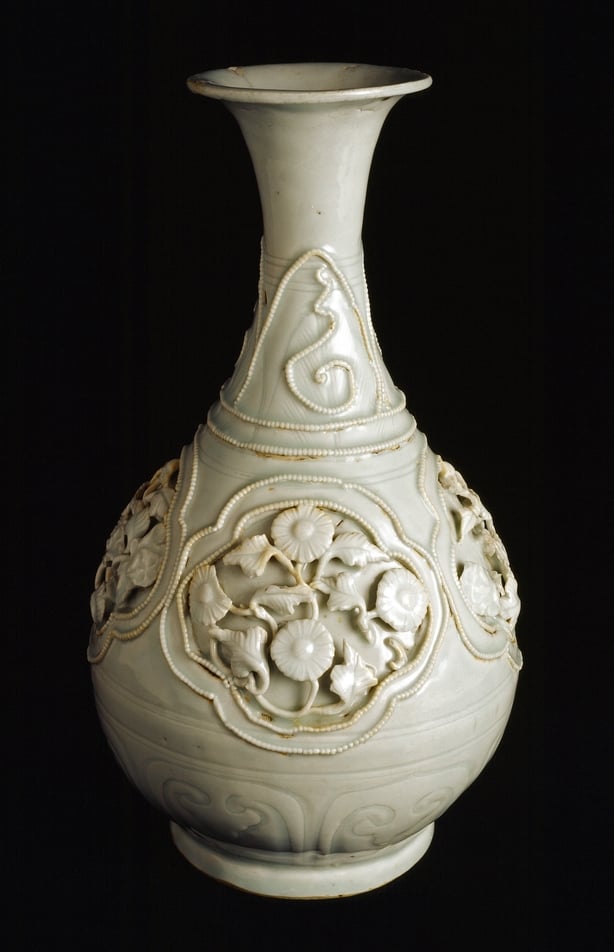Analysis: Here's how one of the rarest pieces of Chinese porcelain in the world ended up in the National Museum of Ireland
It may come as a surprise to many readers that one of the world's rarest pieces of Chinese porcelain resides permanently in Dublin. Made in China around 1300AD, it is the earliest example of Chinese porcelain known to have reached Europe and was owned by royalty for centuries. This is the complex and curious history of how the Fonthill vase ended up in the National Museum of Ireland.
The vase itself isn’t exceptional at first glance and could easily be disregarded were it not for its much-travelled story and survival throughout centuries of upheaval and transfer between owners. It is pear-shaped with decorations of flowering plants around the body and neck. It is 28cm in height and has a pale blue-green glaze known as Qingbai. For an object that is thought to be over 700 years old, it is in remarkable condition and has only minimal damage with little of it visible to viewers.
Nowadays, porcelain is easily accessible and affordable but that was not always the case. Invented over 4,000 years ago in China, porcelain was practically unknown in Europe until the Renaissance (1450-1650), when highly coveted porcelain was imported from China at extravagant prices. Kings, noble patrons, and entrepreneurs all competed with each other for ownership.

Therein lies the Fonthill vase’s significance: Europeans had not seen anything like it. Its pure colour and durability, as well as the delicacy of decoration, were impossible to achieve in European ceramics. Europeans didn’t work out how to make porcelain until 400 years after the Fonthill vase was first unveiled in Hungary.
The Franciscan missionary monk Giovanni di Marignolli, who spent several years in during his travels in the East, is believed to have brought the vase to Europe. Between 1354 and 1355, he stayed in Prague as a court chaplain to the Holy Roman Emperor Charles IV and donated the vase to him. It is recorded through the centuries in the collections of Louis the Great of Hungary, Charles III of Durazzo and the Dauphin of France. The vase was treated as semi-precious stone and given silver-gilt mounts that transform the vase into a ewer of early Gothic style. These are believed to have been mounted by Saxo-Hungarian goldsmiths about 1381.
The upheaval caused by the French Revolution meant that the vase was sent to market. In 1813, it was bought by William Beckford, the owner of Fonthill Abbey in Wiltshire, which is where it eventually got its name. Beckford’s extravagant expenditure caught up with him and Fonthill Abbey and its contents were sold in 1822. The vase vanished for some years and reappeared at a Christie’s auction in London in 1882. The sale catalogue described it as 'A PEAR-SHAPED BOTTLE OF CHINESE CELADON PORCELAIN, with foliage in high relief in four medallions, and ornaments in low relief on the neck and lower part’.
From RTÉ Kids, This Is Art Club! on the Fonthill vase
Crucially, the distinct and elaborate metal mounts were removed, supposedly by a thief during its time in England, and the vase’s significance went unrecognised without them. T.M. Whitehead was Keeper of Ceramics at the National Museum of Ireland and purchased the vase for £28 and 7 shillings, the equivalent of about €5,000 today.
The description of the vase that Whitehead wrote in museum records after he acquired it made no reference to its history, age or the missing mounts. It is unassumingly described in the original museum register as ‘Old Chinese’ so it's likely Whitehead was unaware of its historical importance when he made the purchase and simply liked the look of the porcelain vase from China. This makes it one of the flukiest purchases in the history of the museum.
The vase was identified by ceramics expert Arthur Lane who pieced together the entire story after visiting the collection in Dublin and published it in Burlington magazine in 1961 . His central source for the identification of the vase is a drawing in 1713 which depicts the vase with its metalwork still intact. From various archive sources and rigorous examination of the inscriptions, Lane identified the vase in Dublin as the first credibly documented piece of Chinese porcelain in Europe.
From RTE's Tommy Tiernan Show, interview with Dr Siobhán Doyle, including this excerpt on statues. See full interview on RTÉ Player
Lane's article remains the seminal research on the object. The Fonthill vase has undergone conservation by specialists in the National Museum of Ireland to ensure its stability as a historical object. It returned to Prague on loan in 2016 where it was part of an exhibition by the National Gallery of the Czech Republic and is studied by scholars around the world.
The Fonthill vase is of paramount importance for the history of collecting in Europe and modern knowledge of the Middle Ages. It is a window into a past that was so long ago that it is almost impossible to represent through material objects, let alone ones that are robust enough to go on display in a museum on a permanent basis.
Its trajectory into the collection of the National Museum of Ireland was largely by chance and because of the hunch of a staff member to purchase a piece of porcelain at auction. Lane’s research transformed the object’s history into one that is truly international, transcending countries, classes and centuries.
This story begs the question: what other treasures do we unknowingly have lying in our museum stores, auctions houses and attics that may be of this historical magnitude? Time to start scavenging and researching.
Follow RTÉ Brainstorm on WhatsApp and Instagram for more stories and updates
The views expressed here are those of the author and do not represent or reflect the views of RTÉ








